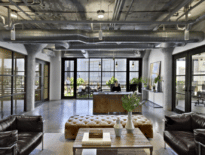Michael Lozano
Vice president of development, Trinity Financial
Age: 44
Industry experience: 20 years
Trinity Financial’s first-ever project in Worcester combines historic preservation with a range of affordability levels, transforming a 19th century courthouse into 115 apartments and bolstering the city’s Lincoln Square revitalization efforts. In 2017, the Boston-based developer was selected to redevelop the 250,000-square-foot Greek Revival structure, which was built in phases beginning in 1843. Developers have opened a temporary sales office and begun taking applications for the first phase of the development scheduled to open in October, which will announce rents for the market-rate units in coming weeks. The $57 million project received $4.5 million from the state’s workforce housing initiative, which has a goal of creating 1,000 housing units for middle-income households statewide.
Q: Did you run across any surprises during the construction given the age of the courthouse buildings?
A: Oh, yeah. We’ve had a lot of surprises. We had a lot of design work before we started construction and we thought we knew what was going on in the building, but until you’re in there you can’t know exactly what’s working behind those walls. We found tons of unforeseen conditions, but we’re working through it and dealing with things as they come. We’re aiming for opening in two phases, essentially 72 units by the end of October and 46 in January.
Q: How many courtrooms does the building contain and how are they being repurposed?
A: We are preserving six of the courtrooms. One of them will be a lounge and community space, and the most elaborate of the courtrooms can be used by all of the residents. And the other courtrooms are being utilized for actual apartments, so it’s going to be pretty spectacular. It’s an amazing building, truly iconic. It was originally built in the 1840s and had multiple expansions through the 1950s, so there’s all of these incredible architectural styles.
Q: How long did it take to assemble your financing?
A: It was complicated. About two-and-a-half years. We utilized historic tax credit, low-income tax credits, workforce housing from MassHousing. We worked with the city on affordability thresholds, and we aimed to get a truly mixed-income community here.
Q: Did historic preservation requirements play a big role in the designs?
A: Our historic consultant was Alisa Augenstein, now with the Public Archeology Lab in Pawtucket, Rhode Island. The building is very historic and we spent an enormous amount of time working with the Massachusetts Historical Commission on the plans. We are preserving a lot of elements within the building: jury boxes and historic fixtures. In some cases, the jury boxes are a structure within units, one is a kitchenette in the lounge.
Q: What supply chain issues have you faced during construction?
A: It’s been a challenging environment, I’m sure for everybody. Our project is no different. We’ve certainly had some with windows and flooring because of labor force disruptions. Fortunately, we’ve got plenty of bricks.
Q: Are you promoting home offices as a feature as work-from-home remains widespread?
A: We have really large unique units, so from that standpoint they lend themselves really well to a live-work situation. We do expect to have a number of people working from home in the building, and to the extent that we can market to that, we will.
Lozano’s Five Favorite Places He’s Visited:
- Angkor Wat, Siem Reap, Cambodia
- Manarola, Cinque Terre, Italy
- Puerto Escondido, Oaxaca, Mexico
- Woods Hole/Oak Bluffs
- Vancouver/Whistler, British Columbia




 |
| 

